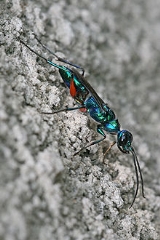
Ampulicidae
Encyclopedia
The Ampulicidae, or Cockroach wasps, is a small (approx. 200 species), primarily tropical group of sphecoid
wasp
s, all of which use various cockroaches as prey items for their larvae. They tend to have elongated jaws, a pronounced neck-like constriction behind the head, a strongly petiolate
abdomen, and deep grooves on the thorax
. Many are quite ant-like in appearance, though some are brilliant metallic blue or green.
Most species sting the roach more than once and in a specific way. The first sting is directed at nerve ganglions in the cockroach's thorax, temporarily paralyzing the victim for 2–5 minutes - more than enough time for the wasp to deliver a second sting. The second sting is directed into a region of the cockroach's brain that controls the escape reflex among other things. When the cockroach has recovered from the first sting, it makes no attempt to flee. The wasp clips the antenna with its mandibles and drinks some of the haemolymph before walking backwards and dragging the roach by its clipped antenna to a burrow, where an egg will be laid upon it. The wasp larva feeds on the subdued, living cockroach.
Spheciformes
The Spheciformes is a paraphyletic assemblage of insect families which collectively comprise the "sphecoid wasps"; these are all the members of the superfamily Apoidea which are not bees, and in older classifications were called the "Sphecoidea"...
wasp
Wasp
The term wasp is typically defined as any insect of the order Hymenoptera and suborder Apocrita that is neither a bee nor an ant. Almost every pest insect species has at least one wasp species that preys upon it or parasitizes it, making wasps critically important in natural control of their...
s, all of which use various cockroaches as prey items for their larvae. They tend to have elongated jaws, a pronounced neck-like constriction behind the head, a strongly petiolate
Petiole (insect)
In entomology, the term petiole is most commonly used to refer to the constricted first metasomal segment of members of the Hymenopteran suborder Apocrita; it may be used to refer to other insects with similar body shapes, where the metasomal base is constricted...
abdomen, and deep grooves on the thorax
Thorax
The thorax is a division of an animal's body that lies between the head and the abdomen.-In tetrapods:...
. Many are quite ant-like in appearance, though some are brilliant metallic blue or green.
Most species sting the roach more than once and in a specific way. The first sting is directed at nerve ganglions in the cockroach's thorax, temporarily paralyzing the victim for 2–5 minutes - more than enough time for the wasp to deliver a second sting. The second sting is directed into a region of the cockroach's brain that controls the escape reflex among other things. When the cockroach has recovered from the first sting, it makes no attempt to flee. The wasp clips the antenna with its mandibles and drinks some of the haemolymph before walking backwards and dragging the roach by its clipped antenna to a burrow, where an egg will be laid upon it. The wasp larva feeds on the subdued, living cockroach.

